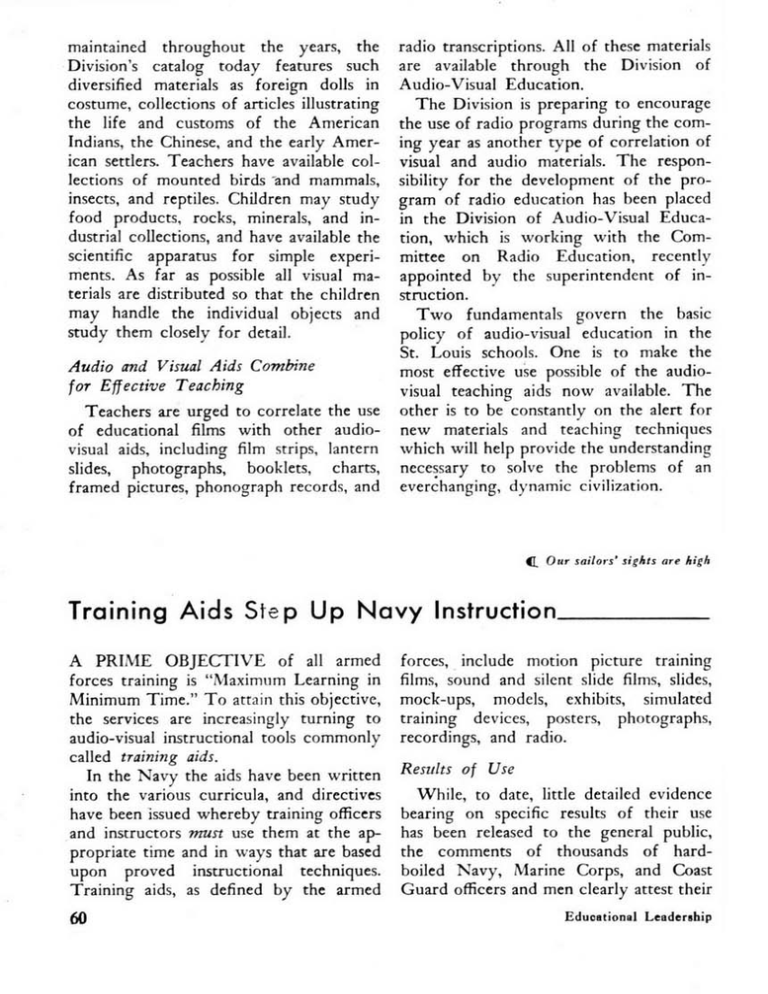
maintained throughout the years, the
Division's catalog today features such
diversified materials as foreign dolls in
costume, collections of articles illustrating
the life and customs of the American
Indians, the Chinese, and the early American settlers. Teachers have available collections of mounted birds and mammals,
insects, and reptiles. Children may study
food products, rocks, minerals, and industrial collections, and have available the
scientific apparatus for simple experiments. As far as possible all visual materials are distributed so that the children
may handle the individual objects and
study them closely for detail.
Audio and Visual Aids Combine
for Effective Teaching
Teachers are urged to correlate the use
of educational films with other audiovisual aids, including film strips, lantern
slides, photographs, booklets, charts,
framed pictures, phonograph records, and
radio transcriptions. All of these materials
are available through the Division of
Audio-Visual Education.
The Division is preparing to encourage
the use of radio programs during the coming year as another type of correlation of
visual and audio materials. The responsibility for the development of the program of radio education has been placed
in the Division of Audio-Visual Education, which is working with the Committee on Radio Education, recently
appointed by the superintendent of instruction.
Two fundamentals govern the basic
policy of audio-visual education in the
St. Louis schools. One is to make the
most effective use possible of the audiovisual teaching aids now available. The
other is to be constantly on the alert for
new materials and teaching techniques
which will help provide the understanding
necessary to solve the problems of an
everchanging, dynamic civilization.
4a Our sailors' sights are high
Training Aids Step Up Navy Instruction
A PRIME OBJECTIVE of all armed
forces training is "Maximum Learning in
Minimum Time." To attain this objective,
the services are increasingly turning to
audio-visual instructional tools commonly
called training aids.
In the Navy the aids have been written
into the various curricula, and directives
have been issued whereby training officers
and instructors must use them at the appropriate time and in ways that are based
upon proved instructional techniques.
Training aids, as defined by the armed
60
forces, include motion picture training
films, sound and silent slide films, slides,
mock-ups, models, exhibits, simulated
training devices, posters, photographs,
recordings, and radio.
Results of Use
While, to date, little detailed evidence
bearing on specific results of their use
has been released to the general public,
the comments of thousands of hardboiled Navy, Marine Corps, and Coast
Guard officers and men clearly attest their
Educational Leadership
enthusiasm and belief in the value and
worth of the aids. Added to these comments are statements from the Army, the
Merchant Marine, and numerous industrial concerns attributing accelerated learning, greater retention of information, and
other results such as increased interest,
clearer concepts, and a generally higher
standard of instruction to the use of audiovisual aids.
on maneuvers, at operational bases for inservice training, aboard ships, and even
aboard submarines where perhaps only one
or two men can observe a film on a catchas-catch-can basis. The Army has probably used them more generally before
larger groups than has the Navy. Naval
training practice encourages small group
use with a maximum of approximately
fiftv mcn....
Today the aids are distributed largely
from about thirty libraries. These libraries
are an integral part of a Training Aids
Section offering comprehensive audiovisual services and are located at the headquarters of each Naval District and at
foreign bases.
Extent of Production and Use
Production figures of some of the aids
stagger the imagination. The Navy Bureau of Aeronautics, Training Film Section, has produced and made available for
distribution more than 700,0o0 ten-minute
reels of training films. The Bureau of
Naval Personnel, Training Aids Develop- Training Aids Centers
ment Center, has distributed more than
Typical services of these Training Aids
3,000,000 small blinker gadgets used in Sections include:
learning code. The production and disi. Ad icc on the selection of aids to
tribution of other aids are proportionately
meet particular training problems.
as large.
2. Advice on proper utilization techThe armed forces are using training aids
niques.
in every conceivable physical situation.
3. Loan of various aids, including necesThe most extensive use is in camps and
sary equipment (usually based upon
training stations. However, they are used"custody pending completion of
use").
Because there was no money, because the
school staff was already overworked, or for
any one of a dozen other reasons, education
has never had the chance to try audio-visual
aids on the impressive scale now being used
in the armed services. Here, then, is a readymade opportunity to learn from the experience
of others. By studying the Army-Navy procedures and considering carefully the services'
evaluations of their own programs, educators
may gain much valuable assistance in planning for the use of audio-visual materials in
the school. The accompanying article, describing the use of training aids in the Navy.
was written by Lieut. Comdr. Francis W.
Noel in Education in the Armed Services,
a pamphlet edited by Lieut. William B.
Brown. This publication may be purchased for
50 cents from the Department of Supervision
and Curriculum Development. NEA, 1201
Sixteenth Street, N. W., Washington 6, D. C.
November, 1944
4. Delivery of the aids.
5. Instruction on the operation of the
equipment.
6. Service of equipment.
7. Preview facilities.
8. Classrooms for ships' crews and operational in-service training groups' use.
9. Limited production of aids peculiar
to local needs.
It is to be noted that each Training Aids
Section has an appropriate number of
utilization officers assigned to its staff
whose job specifically is to work w ith
training officers and instructors in the
selection and proper utilization of avail61
able aids. These officers do not wait for
visitors to come to the section, but rather
go to the activities. A comprehensive
forces-afloat program has been developed
wherein one of the utilization officers visits
the training officer of each ship immediately upon its arrival to help in solving
any particular in-service training problem
he may have.
Utilization Pattern
pattern of use. A pamphlet More Learning
in Less Time gives the over-all philosophy
of selection and use as well as many helpful hints to instructors.'
"What are some of the major conclusions of the armed forces training aids
experience to date?" This question is being
asked with increasing frequency. The full
answer cannot be given at this time. However, even now a few findings for future
guidance of the Navy stand out in bold
and significant relief. They include:
In the Navy, instructional films are not
always used wisely. There are some inI. The development and use of training
structors who show a film and assume
aids must be guided at all times by curricthat training has taken place. The Navy
knows that the mere showing of a film is ulum requirenlents. Aids must implement
usually a waste of time and seldom pro- the curriculrum and must never be allowed
to dictate it.
ductive of any desirable educational out2. All production and distribution of
comes. Naval policy now requires that all
appropriate training aids must be used, and training aids must aim toward and be
that their use must be evaluated in terms guided by the requirements of effective
utilization.
of good instructional practices. This
3. Training aids properly selected and
utilization pattern includes the following
used
can greatly improve all types of
steps:
training.
i. Preview by the instructor.
4. Evaluation and research studies must
2. Selection in terms of a training need. continually be made to provide:
3. Preparation of the class for the aid.
a. The development of more effective
4- Use of the aid.
aids.
5. Discussion and clarification of any
b. Better ways of using them in terms
questions arising.
of good instructional techniques.
6. A short quiz on the aid.
5. To render development of the train7- Procedure as soon as possible to a ing aid movement fundamentally sound,
practical application of the material a comprehensive program of teacherpresented by the aid.
training in the proper selection and use
8. Evaluation of the whole procedure by of the aids is required.
both trainees and instructors.
6. There is a tendency to over-emphaIt has been found that continuous in- size the physical aspects of training aids.
To guard against this, attention must be
structor and student evaluation of the aids
and the way in which they are used are continually focused upon the end resultsTHE IMPIROVEMENT AND ENRICHimportant steps in effective utilization.
IlENT OF LEARNING.
The Bureau of Naval Personnel, Training Aids Section, produces brief study
'Copies available without cost from Bustiness
guides on selected aids, the contents of Screen, 157 East Eric Street, Chicago, Ill. Not
which are organized along this suggested available to the public from Navy sources.
62
Educational Leadership
Copyright © 1944 by the Association for Supervision and Curriculum
Development. All rights reserved.


